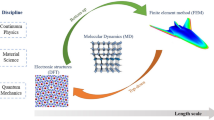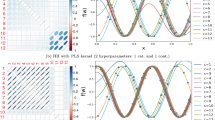Abstract
A method for multiscale simulation and material design of thin membranes using Gaussian processes is proposed to assist in the mechanical analysis and design of woven textiles. Most of the existing concurrent multiscale simulation schemes have a limited capability in the combined mechanical analysis and design of woven textiles. In addition, the inherent higher computational cost of these existing schemes demands the development of efficient analysis techniques using advanced data-driven statistical methods. The contribution of this paper is aimed at utilising the Gaussian process based data-driven concepts in multiscale analysis and designing of woven textiles in a parametric environment. The proposed data-driven nonlinear multiscale modelling technique is proven to efficiently integrate the two scales using Gaussian process regression (GPR) statistical learning technique. In the microscale, representative volume elements (RVEs), parameterised by geometric, and material properties, are modelled using finite deformable isogeometric rods, and their deformation is homogenised using periodic boundary conditions. An offline GPR statistical model is trained for various strain states, geometric, and material properties of woven textile RVEs. In the macroscale, woven textiles are modelled as nonlinear orthotropic membranes for which the stresses and material responses are predicted by the trained GPR model. This offline trained GPR model acts as the constitutive model predictor for a given combination of analysis and design parameters. The efficient integration of statistical learning in multiscale modelling and material design is proven not only to result in efficient mechanical analysis but also to furnish a framework for material design of woven textiles.
















Similar content being viewed by others
Notes
Quantities in the reference and deformed configurations are denoted using uppercase and lowercase letters, respectively.
Macroscale and microscale quantities are denoted by subscripts M and m, respectively.
References
Parsons, E.M., Weerasooriya, T., Sarva, S., Socrate, S.: Impact of woven fabric: Experiments and mesostructure-based continuum-level simulations. J. Mech. Phys. Solids 58(11), 1995–2021 (2010)
Nilakantan, G., Keefe, M., Bogetti, T.A., Adkinson, R., Gillespie, J.W.: On the finite element analysis of woven fabric impact using multiscale modeling techniques. Int. J. Solids Struct. 47(17), 2300–2315 (2010)
Ha-Minh, C., Imad, A., Kanit, T., Boussu, F.: Numerical analysis of a ballistic impact on textile fabric. Int. J. Mech. Sci. 69, 32–39 (2013)
Wang, Y., Liu, X., Zhu, C., Parsons, A., Liu, J., Huang, S., Ahmed, I., Rudd, C., Sharmin, N.: Production and characterisation of novel phosphate glass fibre yarns, textiles, and textile composites for biomedical applications. J. Mech. Behav. Biomed. Mater. 99, 47–55 (2019)
Martens, Y., Ehrmann, A.: Composites of 3d-printed polymers and textile fabrics. IOP Conf. Ser. Mater. Sci. Eng. 225, 012292 (2017)
Chakraborty, S., Manik, C.B.: Fused Deposition Modeling 3D Printing Technology in Textile and Fashion Industry: Materials and Innovation. (2019)
Kim, S., Seong, H., Her, Y., Chun, J.: A study of the development and improvement of fashion products using a FDM type 3D printer. Fashion Text. 6(1), 1–24 (2019)
Schmelzeisen, D., Koch, H., Pastore, C., Gries, T.: 4D textiles: Hybrid textile structures that can change structural form with time by 3D printing. In: Narrow and Smart Textiles, pages 189–201. Springer (2017)
Simo, J.C.: A finite strain beam formulation. the three-dimensional dynamic problem. part i. Comput. Methods Appl. Mech. Eng. 49(1), 55–70 (1985)
Simo, J.C., Vu-Quoc, L.: A three-dimensional finite-strain rod model. part II: Computational aspects. Comput. Methods Appl. Mech. Eng. 58(1), 79–116 (1986)
Simo, J.C., Vu-Quoc, L.: On the dynamics in space of rods undergoing large motions - a geometrically exact approach. Comput. Methods Appl. Mech. Eng. 66(2), 125–161 (1988)
Cardona, A., Geradin, M.: A beam finite element non-linear theory with finite rotations. Int. J. Numer. Meth. Eng. 26(11),(1988)
Kondo, K., Tanaka, K., Atluri, S.N.: An explicit expression for the tangent-stiffness of a finitely deformed 3-d beam and its use in the analysis of space frames. Comput. Struct. 24(2), 253–271 (1986)
Jelenić, G., Crisfield, M.A.: Interpolation of rotational variables in nonlinear dynamics of 3d beams. Int. J. Numer. Meth. Eng. 43(7), 1193–1222 (1998)
Meier, C., Popp, A., Wall, W.A.: An objective 3D large deformation finite element formulation for geometrically exact curved Kirchhoff rods. Comput. Methods Appl. Mech. Eng. 278, 445–478 (2014)
Meier, C., Popp, A., Wall, W.A.: Geometrically Exact Finite Element Formulations for Slender Beams: Kirchhoff–Love Theory Versus Simo–Reissner Theory. Archives of Computational Methods in Engineering, pp. 1–81, (2017)
Meier, C., Popp, A., Wall, W.A.: A finite element approach for the line-to-line contact interaction of thin beams with arbitrary orientation. Comput. Methods Appl. Mech. Eng. 308, 377–413 (2016)
Bauer, A.M., Breitenberger, M., Philipp, B., Wüchner, R., Bletzinger, K.U.: Nonlinear isogeometric spatial Bernoulli beam. Comput. Methods Appl. Mech. Eng. 303, 101–127 (2016)
Herath, S., Yin, G.: On the geometrically exact formulations of finite deformable isogeometric beams. Comput. Mech., pp. 1–13 (2021)
Weeger, O., Yeung, S.K., Dunn, M.L.: Isogeometric collocation methods for Cosserat rods and rod structures. Comput. Methods Appl. Mech. Eng. 316, 100–122, (2017). Special Issue on Isogeometric Analysis: Progress and Challenges
Lestringant, C., Basile, A., Dennis, M.K.: A discrete, geometrically exact method for simulating nonlinear, elastic and inelastic beams. Comput. Methods Appl. Mech. Eng. 361, 112741 (2020)
Kouznetsova, V.G., Geers, M.G.D., Brekelmans, W.A.M.: Computational homogenisation for nonlinear heterogeneous solids, pp. 1–42
Geers, M.G.D., Kouznetsova, V.G., Matouš, K., Yvonnet, J.: Homogenization Methods and Multiscale Modeling: Nonlinear Problems. In: Encyclopedia of Computational Mechanics, 2nd edn. John Wiley & Sons, Ltd, Chichester, UK (2017)
Bris, C.L., Lelièvre, T.: Multiscale Modelling of Complex Fluids: A Mathematical Initiation, pp. 49–137. Springer, Berlin (2009)
Hu, G., Li, D.: Multiscale Modeling and Numerical Simulations, pp. 1402–1407. Springer US, Boston, MA (2008)
Ramos, G.R., Rossi, R.: A novel computational multiscale approach to model thermochemical coupled problems in heterogeneous solids: Application to the determination of the state of cure in filled elastomers. Comput. Methods Appl. Mech. Eng. 351, 694–717 (2019)
Gu, T., Medy, J.R., Volpi, F., Castelnau, O., Forest, S., Hervé-Luanco, E., Lecouturier, F., Proudhon, H., Renault, P.O., Thilly, L.: Multiscale modeling of the anisotropic electrical conductivity of architectured and nanostructured cu-nb composite wires and experimental comparison. Acta Mater. 141, 131–141 (2017)
Stepniewski, M., Breit, M., Hoffer, M., Queisser, G.: Neurobox: computational mathematics in multiscale neuroscience. Computing and Visualization in Science (2019)
Geers, M.G.D., Kouznetsova, V.G., Brekelmans, W.A.M.: Computational homogenization. In: Encyclopedia of Computational Mechanics, 2nd edn. Springer, Vienna (2010)
Geers, M.G.D., Kouznetsova, V.G., Brekelmans, W.A.M.: Multi-scale computational homogenization: trends and challenges. J. Comput. Appl. Math. 234(7), 2175–2182 (2010)
Hashin, Z., Shtrikman, S.: A variational approach to the theory of the elastic behaviour of multiphase materials. J. Mech. Phys. Solids 11(2), 127–140 (1963)
Fillep, S., Orlik, J., Bare, Z., Steinmann, P.: Homogenization in periodically heterogeneous elastic bodies with multiple micro-contact. Math. Mech. Solids 19(8), 1011–1021 (2014)
Ridderbos, K.: The coarse-graining approach to statistical mechanics: How blissful is our ignorance? Stud. History Philos. Sci. Part B Stud. History Philos. Mod. Phys. 33(1), 65–77 (2002)
Babuska, I.: Homogenization approach in engineering. In: Glowinski, R., Lions, J.L. (eds.) Computing Methods in Applied Sciences and Engineering, pp. 137–153. Springer, Berlin (1976)
Voigt, W.: Theoretical studies on the elasticity of the crystals. Abh. Ges. Wiss. Goettingen 34,(1887)
Voigt, W.: Textbook of crystal physics (Teubner Leipzig and Berlin) 980 s. Reproduced 1966 Spring Fachmedien Wiesbaden GmbH (1928)
Reuss, A.: Computation of the yield point of mixed crystals due to hiring for single crystals. Math. Phys 9, 49–58 (1929)
Taylor, G.I.: Plastic strain in metals. J. Inst. Metals 62, 307–324 (1938)
Zaoui, A., Masson, R.: Micromechanics-based modeling of plastic polycrystals: an affine formulation. Mater. Sci. Eng., A 285(1), 418–424 (2000)
Herath, S., Haputhanthri, U.: Nonlinear multiscale modelling and design using Gaussian processes. J. Appl. Comput. Mech., 1–10 (2021)
Herath, S.: Nonlinear material modeling and design using statistical learning. Proc. SSESL Annu. Sessions 2020(1), 66–73 (2020)
Bessa, M.A., Bostanabad, R., Liu, Z., Hu, A., Apley, D.W., Brinson, C., Chen, W., Liu, W.K.: A framework for data-driven analysis of materials under uncertainty: Countering the curse of dimensionality. Comput. Methods Appl. Mech. Eng. 320, 633–667 (2017)
Herath, S., Jayasekara, M., Mallikarachchi, C.: Parametric Study on the Homogenized Response of Woven Carbon Fibre Composites. In: 2020 Moratuwa Engineering Research Conference (MERCon), pp. 36–41. IEEE (2020)
Weeger, O., Sakhaei, A.H., Tan, Y.Y., Quek, Y.H., Lee, T.L., Yeung, S.K., Kaijima, S., Dunn, M.L.: Nonlinear multi-scale modelling, simulation and validation of 3D knitted textiles. Appl. Compos. Mater., pp. 1–14 (2018)
Nadler, B., Papadopoulos, P., Steigmann, D.J.: Multiscale constitutive modeling and numerical simulation of fabric material. Int. J. Solids Struct. 43(2), 206–221 (2006)
Le, B.A., Yvonnet, J., He, Q.-C.: Computational homogenization of nonlinear elastic materials using neural networks. Int. J. Numer. Meth. Eng. 104(12), 1061–1084 (2015)
Ibanez, R., Abisset-Chavanne, E., Aguado, J.V., Gonzalez, D., Cueto, E.: A manifold learning approach to data-driven computational elasticity and inelasticity. Arch. Comput. Methods Eng. 25(1), 47–57 (2016)
Ibanez, R., Borzacchiello, D., Aguado, J.V., Abisset-Chavanne, E., Cueto, E., Ladeveze, P., Chinesta, F: Data-driven non-linear elasticity: constitutive manifold construction and problem discretization. Comput. Mech. 60, 813–826 (2017)
Wang, K., Sun, W.: A multiscale multi-permeability poroplasticity model linked by recursive homogenizations and deep learning. Comput. Methods Appl. Mech. Eng. 334, 337–380 (2018)
Do, H., Tan, Y.Y., Ramos, N., Kiendl, J., Weeger, O.: Nonlinear isogeometric multiscale simulation for design and fabrication of functionally graded knitted textiles. Compos. B Eng. 202, 108416 (2020)
Crisfield, M.A.: Non-linear finite element analysis of solids and structures. Number v. 2 in: Non-linear Finite Element Analysis of Solids and Structures. Wiley, (1997)
Herath, S.: Multiscale modelling of woven and knitted fabric membranes. PhD thesis, (2020)
Ciarlet, P.G.: An Introduction to Differential Geometry with Applications to Elasticity. Springer, Netherlands (2006)
Cirak, F., Ortiz, M., Schroder, P.: Subdivision surfaces: a new paradigm for thin-shell finite-element analysis. Int. J. Numer. Meth. Eng. 47(12), 2039–2072 (2000)
Long, Q., Bornemann, P.B., Cirak, F.: Shear-flexible subdivision shells. Int. J. Numer. Meth. Eng. 90(13), 1549–1577 (2012)
Weeger, O., Narayanan, B., De Lorenzis, L., Kiendl, J., Dunn, M.L.: An isogeometric collocation method for frictionless contact of Cosserat rods. Comput. Methods Appl. Mech. Eng. 321, 361–382 (2017)
Wriggers, P., Zavarise, G.: On contact between three-dimensional beams undergoing large deflections. Commun. Numer. Methods Eng. 13, 429–438 (1997)
Warren, W.E.: The elastic properties of woven polymeric fabric. Polym. Eng. Sci. 30(20), 1309–1313 (1990)
Dinh, T.D., Weeger, O., Kaijima, S., Yeung, S.K.: Prediction of mechanical properties of knitted fabrics under tensile and shear loading: Mesoscale analysis using representative unit cells and its validation. Compos. B Eng. 148, 81–92 (2018)
Herath, S., Xiao, X., Cirak, F.: Computational modelling and data-driven homogenisation of knitted membranes. Int. J. Num. Methods Eng
Rasmussen, C.E., Williams, C.K.I.: Gaussian Processes for Machine Learning. MIT Press, Cambridge (2006)
Bishop, C.M.: Pattern Recognition and Machine Learning. Springer, Berlin (2006)
Herath, S., Haputhanthri, U.: Optimal design and failure prediction using neural networks. Proc. Young Members Tech. Conf. 2020(1), 74–82 (2020)
Herath, S., Haputhanthri, U., Mallikarachchi, C.: Initial design of trusses using topology optimization in a deep learning environment. 2020 From Innovation to Impact (FITI) 1, 1–6 (2020)
Joe, S., Kuo, F.Y.: Remark on algorithm 659: Implementing sobols quasirandom sequence generator. ACM Trans. Math. Softw. 29(1), 49–57 (2003)
Petersen, K.B., Pedersen, M.S.: The Matrix Cookbook. Technical University of Denmark, October 2008. Version 20081110
Holzapfel, G.A.: Nonlinear Solid Mechanics: A Continuum Approach for Engineering. Wiley, New York (2000)
Javier, B., Wood, R.D.: Nonlinear Continuum Mechanics For Finite Element Analysis, 2nd edn. Cambridge University Press, Cambridge (1997)
Pedregosa, F., Varoquaux, G., Gramfort, A., Michel, V., Thirion, B., Grisel, O., Blondel, M., Prettenhofer, P., Weiss, R., Dubourg, V., Vanderplas, J., Passos, A., Cournapeau, D., Brucher, M., Perrot, M., Duchesnay, E.: Scikit-learn: Machine learning in Python. J. Mach. Learn. Res. 12, 2825–2830 (2011)
Acknowledgements
Constructive discussion with Prof. Mark Girolami, Dr. Fehmi Cirak and Dr. Ge Yin at the University of Cambridge is highly appreciated.
Author information
Authors and Affiliations
Corresponding author
Additional information
Publisher's Note
Springer Nature remains neutral with regard to jurisdictional claims in published maps and institutional affiliations.
Rights and permissions
About this article
Cite this article
Herath, S. Multiscale modelling and material design of woven textiles using Gaussian processes. Acta Mech 233, 317–341 (2022). https://doi.org/10.1007/s00707-021-03125-y
Received:
Revised:
Accepted:
Published:
Issue Date:
DOI: https://doi.org/10.1007/s00707-021-03125-y




